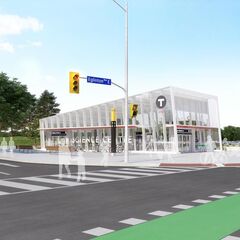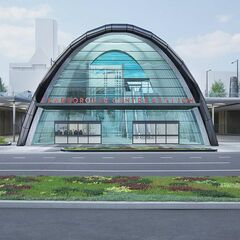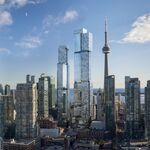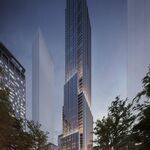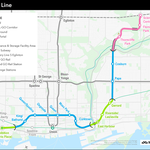On Friday, February 14, the Government of Ontario and the City of Toronto formally signed the preliminary Toronto-Ontario Transit Partnership Agreement to fund and build rapid transit projects in Toronto.
The agreement formalizes a series of terms which City Council approved on October 29, 2019. According to an Ontario news release, it's "the next step towards building the largest subway expansion in Canadian history." It relates to multi-billion dollar investment in transit initiatives over the next twenty years and commits both governments to working together to expand transit in Toronto.
Under the terms of the agreement, the Province will assume sole responsibility for planning, designing and building four priority transit projects:
- building the Ontario Line between Exhibition GO Transit Station and the future Science Centre Station on the Crosstown LRT for a cost of $10.8 billion. (This rapid-transit project replaces the City plans for the Relief Line subway). This line will operate with smaller cars than traditional Toronto subways, but with more frequent service. It also includes long segments of above-ground rail and tunnels. For part of the line, trains would operate beside GO's Lakeshore East and Stouffville rail services.
- extending the TTC's Line 2 Bloor-Danforth subway further into Scarborough with three new stations for $5.5 billion. (The City proposed just one stop);
- extending the Yonge branch of the Line 1 Yonge-University subway into York Region for $5.6 billion; and
- extending the Crosstown LRT further westward along Eglinton Avenue to Renforth Station on the Mississauga Transitway (and, eventually, to a future transit hub at Toronto Pearson International Airport) for $4.7 billion.
Under the plan, the City is reallocating its share of the funding for these projects to upgrade its current transit infrastructure or using the money to support other projects. The proposal also redistributes nearly $3.8 billion in federal infrastructure funding that Toronto has already received. A City staff report indicates $660 million of the funds would support the Line 2 project, while City will also provide $3.16 billion worth of federal dollars to the Ontario Line.
Mayor John Tory explained, "People want us to get on with building new transit and upgrading our existing transit system in Toronto. The signing of this… agreement is an important step in getting this work done and ensuring both governments are working in full co-operation."
The province has committed to invest $11.2 billion in the four transit projects with funding from the city and the federal government expected to cover the remainder of the estimated $28.5 billion cost.
"This almost $30 billion transit expansion is coupled with the City of Toronto's investment of more than $6 billion into our existing transit system, for new subways, new subway signal systems, new buses, new streetcar and station upgrades," Mayor Tory said.
Once construction on these four Provincial priority rapid-transit projects has ended, the TTC will be responsible for operating both them and the current transit network. Ontario and the City will also develop operating and maintenance agreements to outline the specific roles and responsibilities of both parties for the four provincial projects, including who receives revenue from the fareboxes. In the case of two of the projects that extend beyond the City limits, the Province will negotiate with York and Peel Regions and local municipalities to make sure that neighbouring municipal partners contribute to the operating costs.
The Province also commits to reimburse the City for “reasonable costs” resulting from its earlier work in planning, designing and engineering the cancelled relief-line subway and one-stop Scarborough subway extension projects.
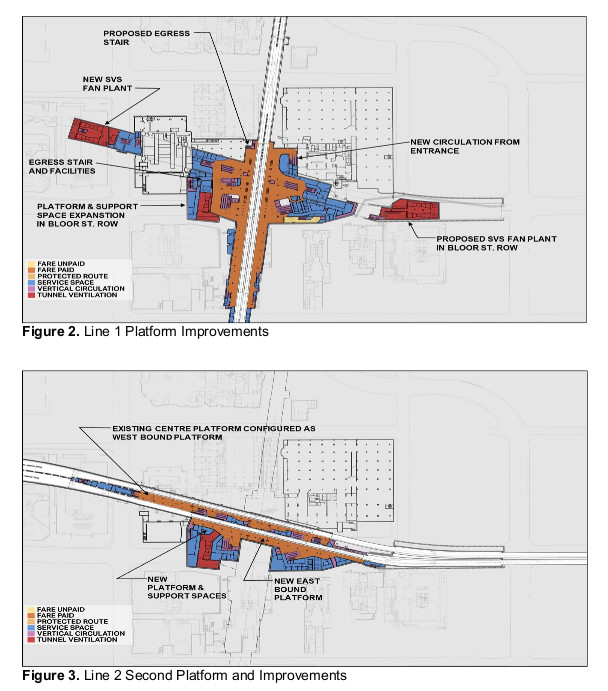 Ontario will help fund the City / TTC project to expand capacity at Bloor-Yonge Station, image, City of Toronto
Ontario will help fund the City / TTC project to expand capacity at Bloor-Yonge Station, image, City of Toronto
Ontario will also continue to advance the Bloor-Yonge Capacity Enhancement Project and the SmartTrack Stations Program through the federal government's Public Transit Infrastructure Fund and also contribute 33 percent of the total capital costs.
Chris Murray, Toronto's City Manager, Michael Lindsay, the Province's Special Advisor to Cabinet—Transit Upload and Ontario Deputy Minister of Transportation Shelley Tapp signed the agreement on behalf of each of the governments.
* * *
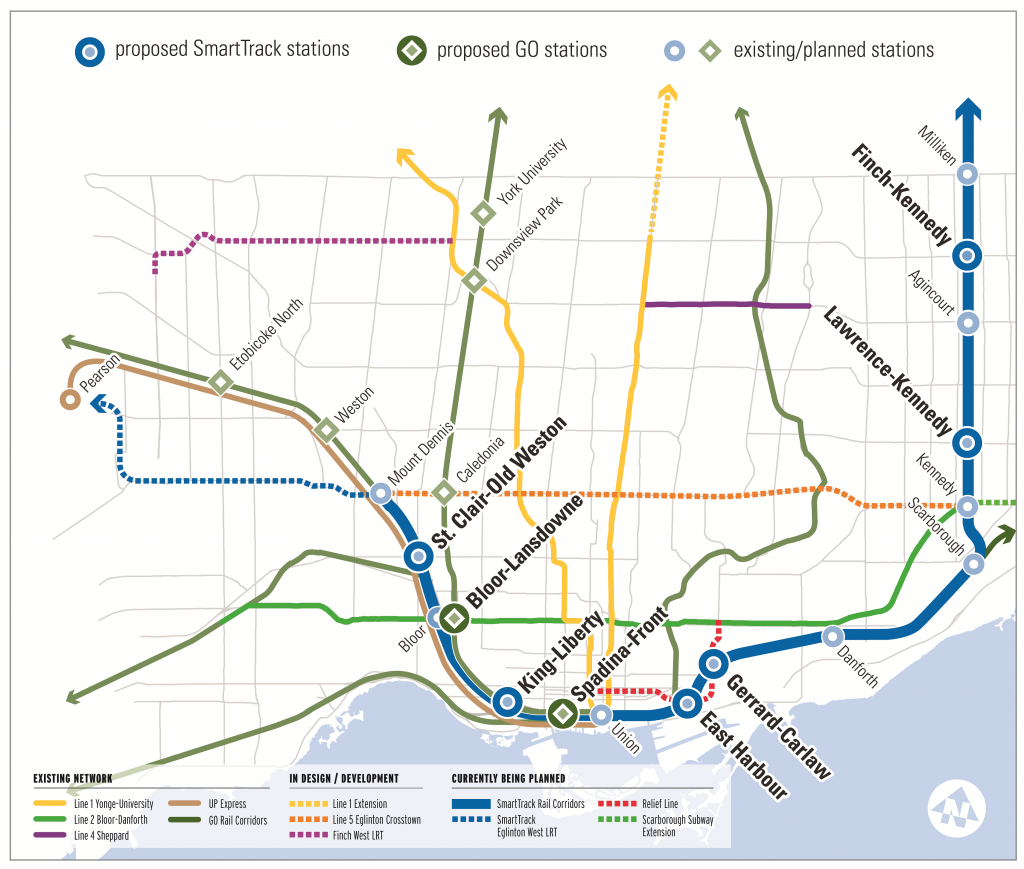 The City proposes six new GO stations in Toronto as part of SmartTrack. Metrolinx intends to build two more, image, City of Toronto
The City proposes six new GO stations in Toronto as part of SmartTrack. Metrolinx intends to build two more, image, City of Toronto
Signing the agreement only finalizes plans that Metrolinx, Ontario's regional transit agency, has been working on since the two governments approved the plan in October. But that's only part of the story. What's been happening with the various projects in the meantime?
Ontario Line
The Province and Metrolinx, are amending the environmental assessment review of the reconfigured rapid transit line by piggybacking on some of the design and engineering work that City and TTC staff had already completed for the Relief Line South project. And they've held a series of public meetings to present their preliminary plans for the line to neighbours. While those events revealed little that was new to transit observers, some residents were more than a bit shocked by the fact that the line would be above-ground in their communities.
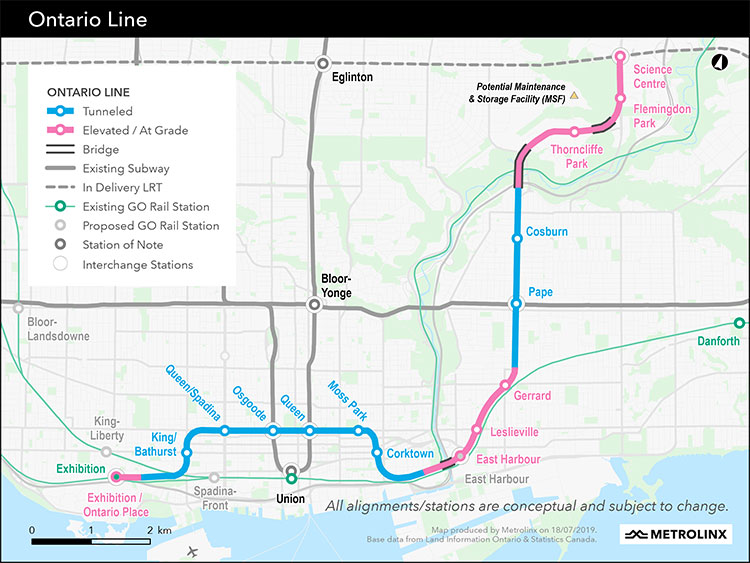 The Ontario Line stretches 16 kilometres, has 15 stops and includes both above- and underground segments, image, Metrolinx
The Ontario Line stretches 16 kilometres, has 15 stops and includes both above- and underground segments, image, Metrolinx
Trains on the line will head southward from Eglinton along an elevated structure over Don Mills Road and Overlea Boulevard through the Flemingdon Park and Thorncliffe Park areas.
In an news article last December, the Toronto Star's transportation writer Ben Spurr explains,
"...there is little dispute that providing rapid transit to the low-income, immigrant communities in Thorncliffe and Flemingdon is a major benefit of the Ontario Line. And yet, the specific design of the line looks certain to generate controversy—the province’s intention to operate trains on an elevated guideway for portions of the route is already facing opposition in Thorncliffe and Flemingdon, just as it has in more affluent neighbourhoods elsewhere along the proposed alignment.
"Deputy Mayor Denzil Minnan-Wong, the councillor for the Don Valley East ward that includes Flemingdon Park, said his constituents are 'excited by the idea that this area that was pretty much ignored in transit planning is finally right on the map.'
"But 'the one thing that residents are raising is that they would like to see something underground,' he said. 'They don’t believe that they should be treated any differently than communities that are in the downtown that are also wanting underground transit.'"
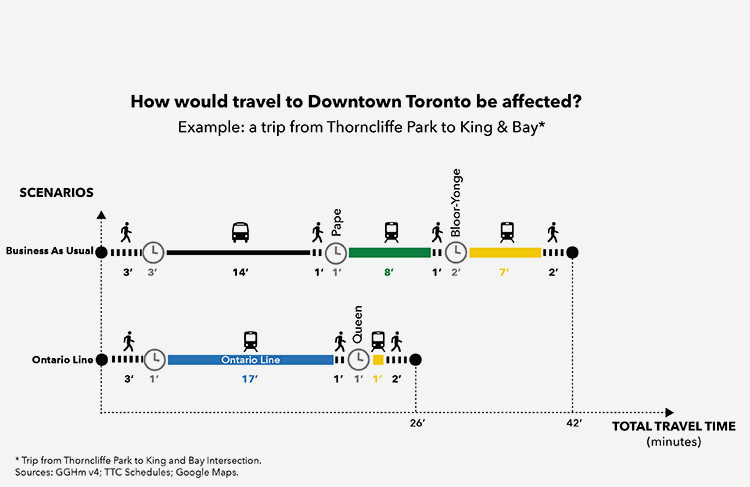 Metrolinx says the Ontario Line would improve travel times between Thorncliffe Park and downtown, image, Metrolinx
Metrolinx says the Ontario Line would improve travel times between Thorncliffe Park and downtown, image, Metrolinx
The area is key to Ontario Line plans—Metrolinx is proposing to build a maintenance and storage facility in the vicinity and also intends to build a new bridge west of the Leaside Viaduct (Millwood Road) to carry trains across the Don River Valley. South of this bridge, trains would plunge into a tunnel under Pape Avenue, connecting with the TTC's Line 2 Bloor–Danforth subway at Pape Station.
Just north of Gerrard Street East, the line would again emerge above-ground to operate on tracks parallel and to either side of the GO and VIA tracks. And, here again, neighbours are mobilizing to oppose the plan and urging Metrolinx to bury the line.
On the community news site Toronto.com, senior writer David Nickel reports,
"Almost a decade ago, in 2011, some Leslieville residents may have rolled their eyes when they heard former councillor Doug Ford and his brother, the late Mayor Rob Ford, chant 'Subways, subways, subways,' as they pushed for underground mass transit instead of surface light rail lines in Scarborough.
"It is a chant that echoes with a certain irony now, as residents in that same community are faced with a sentiment that is at least superficially similar. Doug Ford, now Premier of Ontario, is preparing to run a portion of the new Ontario rapid transit line overground, along rail lines between Eastern Avenue and Gerrard Street East in Leslieville.
"... the trains will run alongside GO trains on the GO corridor, widening that corridor to six tracks from three. That’s in contrast to the Toronto Transit Commission’s defunct plans for a downtown relief line that would have not served as many communities but would have featured a tunnel through Leslieville and underneath the Don River.
"Metrolinx spokesperson Anne Marie Aikins noted that the decision to go above ground is a cost-saving measure to allow for the longer route and would also make the stations in Leslieville easier to access.
"[Local resident Kate Hilton] argues that the six-track, above-ground line has potential to make other things more difficult for the community, raising safety and noise issues (the Ontario Line is expecting to run trains every 90 seconds in each direction, which means a train will pass through every 45 seconds or so). There's also the potential for large-scale property expropriations along the line; and questions about what the future will be for community assets such as the Jimmy Simpson Community Centre and park, which abuts the GO right of way.
"And it is all complicated by the fact that the GO right of way will also contain new tracks for Metrolinx’s Regional Express Rail (RER) expansion which, once complete, will be running more frequent trains there as well."
Since October, crews have been conducting "geophysical surveying" in multiple locations along the route of the Ontario Line, meaning they're assessing underground soil conditions and locating utilities.
According to Metrolinx, the 16-kilometre line will have 15 stops and attract 390,000 daily boardings. Metrolinx says the line will open to passengers in 2027.
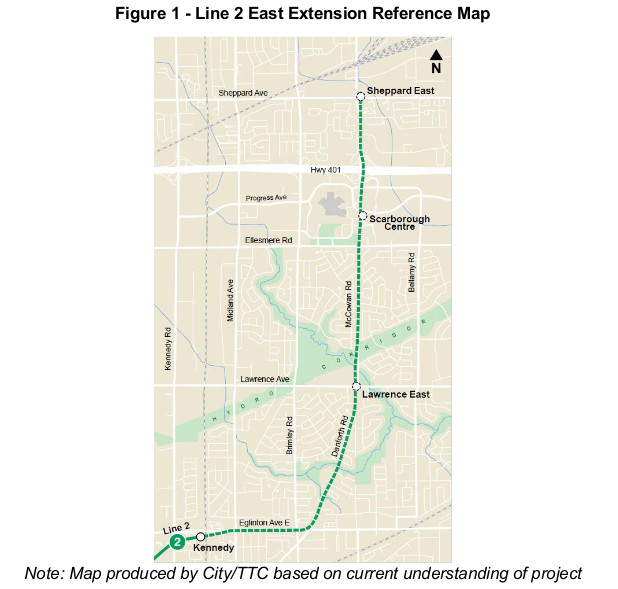 Ontario proposes a three-stop extension of Line 2, image, City of Toronto / TTC.
Ontario proposes a three-stop extension of Line 2, image, City of Toronto / TTC.
Line 2 extension
The City had proposed a one-stop extension between Scarborough Centre and Kennedy stations and was close to contracting for preliminary construction of the line, before the provincial government stepped in to assume control of the project. Ontario plans to extend the line one stop further north to Sheppard and added an intermediate stop at Lawrence.The Line 2 extension would replace the aging Line 3 Scarborough rapid transit service.
Metrolinx is preparing a preliminary design business case,which staff will present to the Metrolinx Board in the near future.
The TTC and the City had already extensively surveyed areas near the line; Metrolinx has started more geophysical surveying for the "new" sections of the line north and south of Highway 401. It's targetted 2029 to 2030 for finishing the 7.8-kilometre extension.
The City had also fleshed out plans for a large bus terminal at Scarborough Centre, which may or may not be required any longer, now that the end of the subway line will be further north.
 The City had planned to build a large bus terminal at Scarborough Centre Station, image, City of Toronto
The City had planned to build a large bus terminal at Scarborough Centre Station, image, City of Toronto
Another important question about this project also remains unanswered: What happens to the TTC's Line 3 until the new Scarborough subway opens? The City and TTC had already committed to extending the line by 2026, just before the aging Scarborough RT trains reach the end of their operating life. Will the province offer and fund solutions if the cars become inoperable before the longer subway is available for passengers?
Line 1 extension
Metrolinx is also updating the business case for this project, which it intends to present to the Metrolinx Board in 2020. Teams are using previous work the City of Toronto, the TTC, York Region and York Region Rapid Transit Corporation completed to move this project forward as quickly as possible.
The timing of the project is a major concern for Torontonians that ride the line—extending it further north may overwhelm the line further south, where it's already operating at capacity.
The Province has promised that it won't open this line until after it's operating the Ontario Line, which, it hopes, will relieve some of the congestion on the lower parts of the Yonge branch of the subway line. It says the extended line will open in 2029 or 2030.
The four municipal partners originally proposed a storage facility to hold trains overnight north of YRT's Richmond Hill Centre Terminal, near Highway 7 and that is likely still part of the plan.
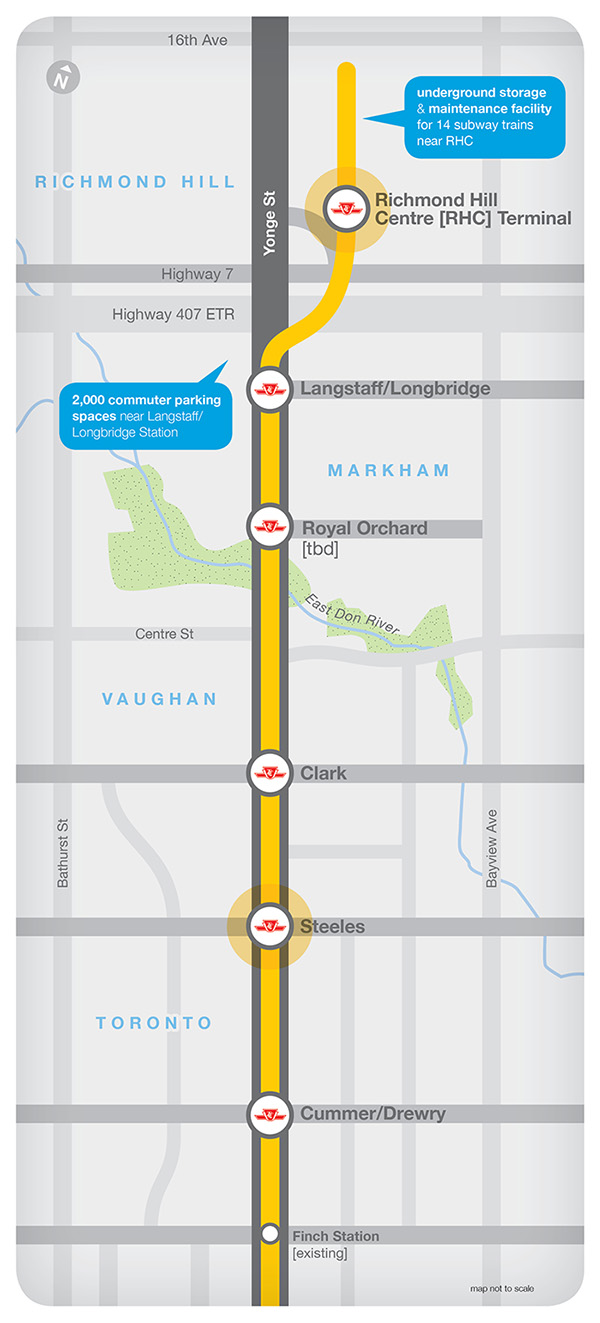 The Line 1 extension now includes six possible stations, image, vivaNext
The Line 1 extension now includes six possible stations, image, vivaNext
Ontario has added a station at Royal Orchard. Plans for the extension originally included a stop at this street, but York Region and the TTC decided to drop the station from their plans by 2012 as ridership forecasts were too low to justify the cost of building a subway station. Planners estimated that, in 2031, the number of morning rush-hour riders using the station would be just 340, about 66 per cent less than than the least-used TTC station, Line 4's Bessarion Station on Sheppard Avenue East. The station site is also constrained by its proximity to the East Branch of the Don River and the Thornill Village Heritage District, which restrict development opportunities nearby.
The TTC and YRT have extensively surveyed land near Yonge Street to determine underground conditions; surveying continues.
Crosstown Eglinton West extension
When last we checked in with this project, the City proposed a 10-stop extension of the Crosstown LRT on the surface along Eglinton Avenue West. The line would stretch westward from Mount Dennis to Renforth Station on the Mississauga Transitway and then (probably) northward to a future transit hub at Toronto Pearson International Airport.
The Province and Metrolinx have not yet released many details, other than to announce that "The Initial Business Case is being prepared and will be presented to the Metrolinx Board. Teams are using previous work completed by the City of Toronto and TTC to move this project forward as quickly as possible."
Ontario has a completely different vision for this project, saying it would have fewer stops and would also operate underground. One major barrier to a completely underground line would be the wide Humber River Valley between Weston and Scarlett Roads.
 The City had approved a 10-stop surface LRT on Eglinton West, image, City of Toronto
The City had approved a 10-stop surface LRT on Eglinton West, image, City of Toronto
The project already has a powerful partner. In April 2018, the Greater Toronto Airports Authority (GTAA) announced that it would be working with Metrolinx to study potential connections for the Kitchener rail corridor to its future regional transit and passenger centre and other potential transit connections such as the Crosstown Eglinton West LRT. The GTAA contributed $38 million to the study. Then, last November the airport authority announced it was investing another $40 million to partner with Metrolinx and advance the technical work necessary to extend the LRT between Renforth and the airport.
According to Metrolinx, the line will open in 2031.
* * *
What do you think of the various projects? Add your comments in the form below, or join the discussion in our various dedicated Forum threads:
- Ontario Line;
- Line 1 extension to York Region;
- Line 2 extension to Scarborough;
- Eglinton West LRT;
- Pearson Transit Hub;
- SmartTrack; and
- Bloor-Yonge Station capacity improvement.
* * *
UrbanToronto has a new way you can track projects through the planning process on a daily basis. Sign up for a free trial of our New Development Insider here.
| Related Companies: | Arcadis, Precise ParkLink, Urban Strategies Inc. |

 15K
15K 



